A construction worker died building a $10,000 per square foot development. His death went unacknowledged and the developer was only charged a $12,500 fine, a Documented investigation found.
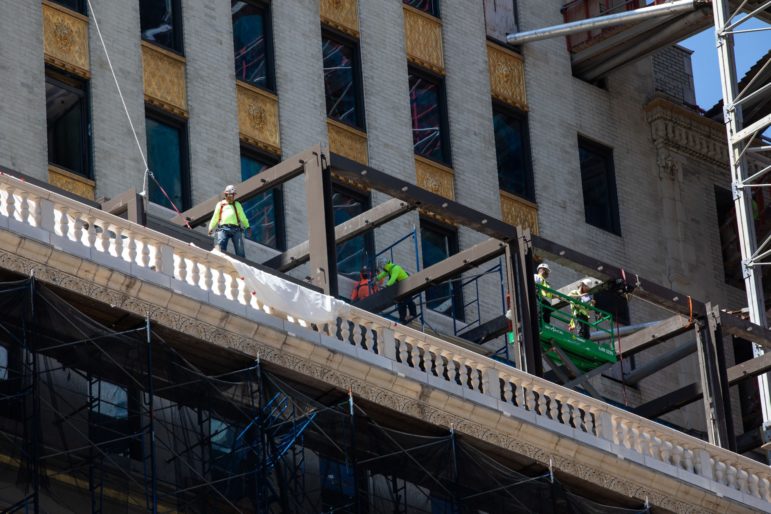
Courtesy of Documented
Construction workers at the Crown Building, in Midtown Manhattan, New York on June 18, 2021.
This story was reported and originally published by Documented on Sept. 8, 2021
When the Aman Hotel & Residences on Fifth Avenue in Manhattan is completed, it will feature an 83-room hotel, topped by 22 private apartments, with all of the amenities that the super-rich could imagine. Atop the Crown Building, a landmark named for its gold-foil roof that resembles a royal crown, the project will provide apartment owners with private terraces and infinity pools one block away from Central Park. The lucky buyer of the five-story penthouse will be able to indulge in an indoor and outdoor pool, a meditation suite and bedrooms with wood-burning fireplaces.
The cost of building such luxury: an estimated $1.4 billion. The developers of 730 Fifth Avenue, OKO Group and SHVO, are confident about getting a return on their investment even amid the shaky economic recovery of the post-pandemic era. The penthouse has already attracted a $180 million offer, which will make it one of the priciest residences sold in New York City. Overall, offers for the residences have shattered records in absolute sale prices and price per square foot — $10,000 on average.
There are, however, hidden costs of many such projects — though those are rarely borne by the developers.
Earlier this year, a worker cleaning around a stairwell on the 17th floor, where a trash chute was being installed, fell through a poorly protected hole and landed one floor below. The worker, non-unionized, was taken to a nearby hospital for evaluation of “moderate injuries,” and eventually died.
That’s about all of the information about the construction worker death that is publicly available. The worker’s sex, name, age, ethnicity, nationality and immigration status are all missing from the public databases at the city, state and federal levels. Documented’s efforts to learn the worker’s identity and other details were unsuccessful.
But if the pattern of the last several years is an indicator, this worker was likely male, Latino and an immigrant. The worker likely was also undocumented. Although there is no publicly available indication that the contractor at the Crown Building employed undocumented laborers, according to anecdotal evidence gathered by advocates for immigrant workers, most construction site fatalities in New York are of undocumented people. These are the workers, undercounted and often undetected, who bear the brunt of the real estate boom in the city, advocates said.
Despite promises of protection and efforts to legislate and implement improved safety measures — and impose stiffer penalties for those corporations that violate the regulations — all levels of government continue to fail at protecting the most vulnerable workers, according to advocates for immigrant workers.
Even the extent of the problem is obscured, with various reporting mechanisms operating on different schedules and releasing diverging information. The latest consolidated tally of worker fatalities in construction sites in New York, from 2019, was just released in March by the Bureau of Labor Statistics. That year, 60 construction workers died in New York State — 26 of whom were killed in the city. The Department of Buildings recorded 12 fatalities in 2019; the Occupational Safety and Health Administration, just eight. For 2020, even estimates are unavailable.
“The lack of accountability and enforcement has allowed predatory construction developers to continuously build in New York City and to figure out how to avoid any responsibility,” said Ligia Guallpa, executive director of the Worker’s Justice Project, a nonprofit advocating for low-wage immigrant New Yorkers.
Repercussions for safety violations are rare and inadequate: The Manhattan District Attorney’s Office, for instance, has scored two criminal convictions of construction companies for the deaths of workers at their sites —the most recent one concerning a 2017 accident. In Brooklyn, the most recent indictment announced by the District Attorney’s Office stemmed from the case of Luis Almonte Sánchez, an immigrant from the Dominican Republican, buried by a collapsed wall in September 2018. But such cases are uncommon. In most cases, the people sent to jail have been mid-level managers or foremen, not developers or company executives.
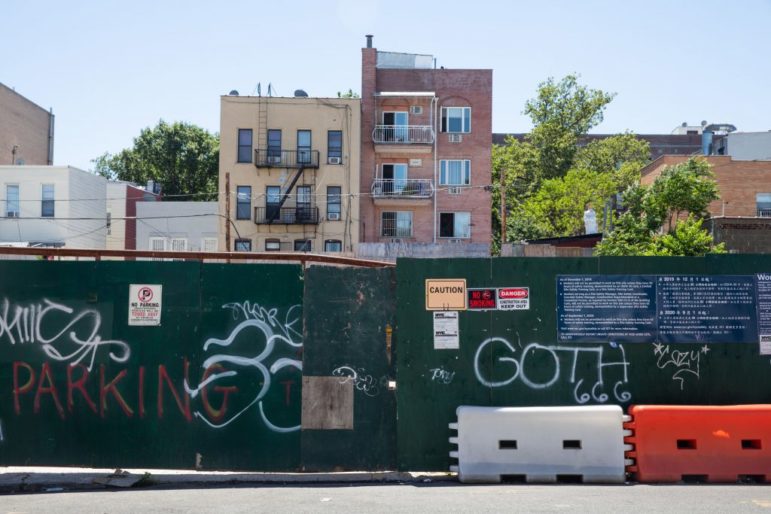
Oscar Duran for Documented
A construction site at 714 39th Street in Sunset Park, Brooklyn, where construction worker Luis Almonte Sanchez died in 2018, photographed on June 24, 2021.
For the companies convicted for violations leading to a construction worker death at a site in New York, the maximum penalty according to the state penal code is $10,000 — the average price per square foot in the Aman Residences. Such a penalty could easily be absorbed as a cost of doing business. The Occupational Safety and Health Administration (OSHA) and the New York Department of Buildings can also separately impose fines above $10,000, although that is not always the case even when a code violation leads to a fatality.
Even small efforts to rein in violations seem lacking. The federal government has decreased both the number of inspections and press releases about health and safety violations, even though a single press release naming a violator can result in a 73 percent improvement in compliance by other companies, according to a 2020 Duke University study.
Moreover, repeated safety violations do not prevent contractors from receiving government subsidies or getting big contracts, even as studies have found that ignoring or skirting rules often foreshadow fatalities: All of the federally inspected sites with construction fatalities in New York State in 2019 also had safety violations, subsequent investigations found.
Advocates say these failures to protect workers take place as the construction industry solidifies its political power in New York. The industry has given generous campaign donations to candidates for offices at all government levels. Former Gov. Andrew Cuomo, for example, raised $6 million during a six-month period before his 2018 re-election campaign, of which at least $1.24 million came from the real estate industry, according to an analysis of state election records.
But the fact that there are so few instances of criminally liable contractors for the deaths of workers on construction sites (just two cases with convictions and $10,000 fines in Manhattan’s history) also has to do with who these workers tend to be: undocumented, non-unionized and Latino.
“When you see fatalities in other industries, fatalities among, frankly, non-immigrant people, often times you do see that there’s just more of a general public outrage,” says Charlene Obernauer, executive director of the New York Committee for Occupational Safety and Health, a nonprofit that publishes a yearly report on fatalities. “It is just a different level of outrage that we see in the public.”
The Russian Billionaire
The construction worker death at the Crown Building illustrates many of the weaknesses in worker protections. The property is owned by OKO Group, which partnered with SHVO to create the Aman Residences & Hotel. Founded by Vladislav Doronin, a Russian businessman, OKO Group is an international real estate development firm whose flagship project is the Aman brand — 32 luxury hotels in 20 countries.
Doronin, a billionaire who was once married to the British supermodel Naomi Campbell, is one of Russia’s largest real estate developers and owner of the OKO Tower, the tallest building in Moscow.
SHVO, which cites a $7 billion portfolio of properties, was founded by Michael Shvo, an Israeli. Shvo pleaded guilty to tax fraud in New York in 2018, charged with evading the payment of $1 million in state and local taxes with purchases of fine art, furniture, jewelry and a luxury sports car. He was subsequently removed from the day-to-day operation and the marketing campaigns of the Aman in New York.
Neither of these developers has been linked to the construction worker death on Feb. 15. They face no liability despite their ownership of the property and profit interest. SHVO representatives declined to comment on the record about the case. Neither OKO Group or Aman spokespersons responded to Documented’s repeated requests for comment.
A Department of Buildings violation report names Gilbane Building Company, one of the top contractors in New York City, as responsible for the violation that led to the Feb. 15 fatality. The company, which has a 150-year history and offices in 10 countries, has worked extensively with the state on numerous public projects, even after being targeted by several union protests in New York. In a series of rallies in 2016, the Building and Construction Trades Council denounced that the company’s subcontractors paid lower than the union-stipulated wages and did not “adhere to top quality safety standards.” The company denied the allegations.
Gilbane is a member of the New York Construction Alliance (NYCA), whose 850 industry professionals pursue a common goal: “to advance open shop construction,” which means employing both union and nonunion labor. Nonunion workers are generally immigrants. The New Immigrant Community Empowerment (NICE), a nonprofit advocating for vulnerable workers’ rights in New York, estimates that close to 90 percent of the almost 500 construction workers who have perished in New York State construction sites in the last decade have been immigrants.
Gilbane has been a generous campaign contributor and lobbyist, giving tens of thousands of dollars in political contributions nationwide. It has hired 176 Congressional lobbyists over 17 years, for which it has reported spending $3.6 million.
An ongoing federal Occupational Safety and Health Administration (OSHA) investigation of the Feb. 15 construction worker death encompasses two more companies involved in the Aman construction: the Turkish company Ant Yapi, debuting in the United States market through a joint venture with Gilbane, and Labor Innovations Corp, the “subcontractor that employed the decedent,” according to a safety and health administration spokesperson. There is not much public information about Labor Innovations, which is based in Wappingers, N.Y., with 38 employees. The company did not reply to repeated requests for comment.
The layers of companies allow big corporations to shift the responsibility for wrongdoing to relatively small subcontractors, worker advocates say. “The most powerful manage to hide and consider themselves the least responsible,” said Sara Feldman, worker rights director at the nonprofit NICE. The real estate developers should also be held to account when a worker dies in their property, she added, not just the supervisor or the foremen, who are often likely immigrants.
Of the companies involved with the Crown Building construction, only Gilbane has been held responsible for the Feb. 15 death of its worker so far. The Department of Buildings issued a $12,500 civil fine when inspectors found that Gilbane’s failure to properly install the covering of the garbage chute hole “caused worker to fall” from the 17th to 16th floor.
A New York City Department of Buildings list of construction-related accidents reported that a level 2 building code violation—an aggravated offense considered a major violation—was issued for “a failure to institute adequate safety measures.” A hearing at the Office of Administrative Trials and Hearings is scheduled for Sept. 21.
After the accident, a partial Stop Work Order was imposed for the 16th and 17th floors of the Crown Building. The order was rescinded two days after the worker’s fall.
Gilbane did not report details of the fatal accident within three business days to the buildings department, as Local Law 78 requires, according to a Department of Building’s spokesperson. The incident is not on the records. A violation carries a potential $2,500 penalty.
In addition, after the fatal accident, the Department of Buildings conducted a full safety sweep of the site, and its inspectors detected 11 code violations, all of them deemed immediately hazardous or major. In total, Gilbane accumulated 32 violations from February 2019 to June 2021 while working on the Aman project, for which the company was fined more than $35,000. Most of that money has not been paid.
Gilbane has also attracted 87 federal Occupational Safety and Health Administration (OSHA) inspections from 2016 to 2021 for workers’ safety and health violations nationwide. OSHA inspections are initiated by the agency although they are usually triggered by workers’ complaints of possible safety hazards. All of the 31 inspections conducted by OSHA on Gilbane-operated sites since 2019 registered these workplaces as “nonunion.”
In August, OSHA imposed a $28,671 fine on Gilbane and Ant Yapi for three different violations of federal safety standards concerning the Feb. 15 construction worker death. As of Sept. 7, the companies have not paid the OSHA or the Department of Buildings fines.
Gilbane did not respond to multiple requests for comment.
Opacity with the Construction Worker Death
There were numerous ways in which the Feb. 15 death revealed the lack of transparency and accountability surrounding fatalities in the construction industry in New York.
There is no consolidated tally of workers killed in construction sites in New York, until two years after the incidents, and it contains only scarce data on the victims, the employer, the location and ownership of the property where a fatality occurs. The owners of the properties, the real estate developers, are shielded from accountability through several layers of contractors and subcontractors, who face the civil and criminal consequences for the deaths.
For these crimes, the people sent to jail have been mid-level managers and foremen — often Latin American immigrants as well. Meanwhile, the companies responsible for the properties where fatalities occur do not lose their licenses of operation or access to state contracts, even when sued in courts. They do not even pay a reputational cost for the deaths of undocumented workers as most of the details on the fatalities are not publicly available.
Despite Documented’s extensive efforts, not even the worker’s name and other basic details of the deadly Feb. 15 accident were made public.
A Department of Buildings spokesperson told Documented that the agency did not have “identifying information” regarding the deceased. A request filed in April through New York’s Freedom of Information Law was set to be responded to in July, but was delayed. An OSHA spokesperson said the agency could not disclose additional details until their investigation concluded. And a representative for the city Department of Investigations said the office — which determined that it would not probe the case since no criminal intent or negligence was detected — only releases information on “substantiated matters.”
A union would have registered the death of one of its members but, according to the OSHA report of the fatality on Feb. 15, the worker killed at the Crown Building was nonunion.
The worker’s death, which occurred 17 flights up, was not witnessed by people outside the construction site and he died later at the hospital, making it less likely that the police would notify reporters about the incident. Without media attention, the Aman Residences seems to have eluded the reputational costs that other buildings have endured when a construction worker death is related to a safety code violation.
In contrast, the death of another construction worker, Mario Salas, in July 2020 drew widespread publicity. Salas, 59, was killed in a mid-town Manhattan renovation by Edras Group, a 22-employee subcontractor based in New Jersey. The construction worker death was reported by the media, and advocates organized a vigil outside the building where he worked and a rally that started in front of then-Gov. Cuomo’s Manhattan office.
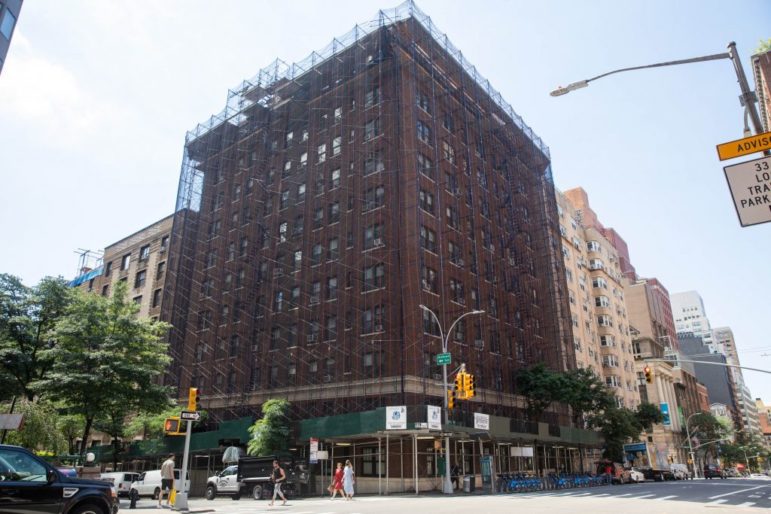
Oscar Duran for Documented
The building at 136 East 36th Street in Murray Hill, New York, where construction worker Mario Salas died in a scaffolding collapse in 2020, photographed on June 24, 2021.Advocates said that kind of publicity generally pressures the industry to enforce safety regulations, although in Salas’ case, Edras Group was ultimately not fined by OSHA or the City’s Department of Buildings despite its “failure to institute adequate safety measures.”
“No employer wants to be associated with workers’ deaths on their job sites,” said Obernauer, executive director of the New York Committee for Occupational Safety and Health. “And they want to be associated with the death of undocumented workers even less.”
Publicity has been such a powerful enforcer that OSHA’s issuance of a single press release about a company’s severe violation has as much impact on safety compliance as 210 OSHA inspections, concluded Matthew Johnson, assistant professor at Duke’s Sanford School of Public Policy in a 2020 study.
Yet OSHA’s most recent press release about a safety violation by a New York construction company was about a 2018 death in East Harlem.
In the New York legislature, attempts have been made to shed light on construction workers’ deaths to improve safety compliance and accountability. A bill signed by former Gov. Cuomo in February establishes a public registry of workplace fatalities in the construction industry in New York State. Within three months of an incident, the registry will publish online the name of the employer as well as the name and age of the worker, their ethnicity, nationality, immigration and union status.
“We cannot let contractors get away with whatever they want without facing serious consequences,” said State Senator Jessica Ramos of Queens, the bill’s sponsor, during a rally in Battery Park for Workers’ Memorial Day on Apr. 28. “We have created a registry of the workers killed in construction sites so at least we can have updated statistics in the state. From that basic point, we have had to begin.”
Republicans in the State Assembly opposed the registry, arguing that it would duplicate OSHA’s, according to Assemblywoman Carmen de la Rosa, a Democrat representing Upper Manhattan who sponsored the bill in the Assembly. The registry has to be fully implemented by December 2021.
“We know that many times, although OSHA is investigating the deaths, those deaths are not always reported back to the states,” said de la Rosa. The registry’s goal, she added, is to “see what those demographics look like, who are the people that are dying in construction sites. We know who they are — they are immigrants — but we need to put this out to the public.”
The lack of timely information about workers’ deaths disproportionately affects undocumented workers, who have far fewer resources to seek redress. “If there is not an advocacy campaign when there is a fatality of an undocumented worker, that worker will not get justice,” Obernauer said.
Lack of Political Will
A major complaint regarding construction workers’ fatalities in New York has been that even the very few companies criminally convicted for fatalities do not feel the impact financially.
State Senator James Sanders, a Democrat of Queens, has sponsored a bill that would designate worker endangerment as third, second and first-degree felonies, with a penalty as high as $500,000. Called Carlos’ Law, it is named after Carlos Moncayo, a 22-year-old Ecuadorian immigrant who was buried alive when an unsecured trench caved in on him in the Meatpacking District in Manhattan in April 2015.
Harco Construction, the company that managed the project, was convicted of manslaughter in the second degree, criminally negligent homicide and reckless endangerment for repeatedly disregarding warnings about inadequate fortification to the excavation site. Yet the company paid only the maximum penalty of $10,000.
District Attorney Cyrus R. Vance of Manhattan and Mark Peters, the Department of Investigations Commissioner of New York, in a joint statement called the fine “Monopoly money.” But Carlos’ Law, which passed the Assembly, remains in the Code Committee four years after it was introduced in the Senate.
Still, Moncayo’s death was the first in the modern history of New York in which a contractor was found criminally guilty for the death of one of its workers. Wilmer Cueva, a foreman for Sky Materials Corporation, the subcontractor that hired Moncayo, was sentenced in December 2016 to a maximum of three years in prison for repeatedly ignoring safety warnings before the fatal excavation collapse. Alfonso Prestia, a Harco supervisor, was sentenced to community service and probation after a jury deadlocked.
Worker advocates were still disheartened by the outcome.
“They only prosecuted the employer who hired the worker at the construction site and Harco, the general contractor, although they were many layers above them,” said Nadia Marin-Molina, co-executive director at the National Day Laborer Organizing Network, a nonprofit advocating for day laborers. “That was very frustrating in Carlos’ case.”
Amid the challenges, the crucial ingredient for prosecuting employers seems to be political will, advocates said. The Carlos Moncayo case inspired the creation of the Construction Fraud Task Force in the Manhattan District Attorney’s Office, meant to offset the culture of cronyism “that too often accompanies these multi-million dollar projects,” Vance said. However, besides the Moncayo case, only one other criminal conviction for a construction worker death has been achieved in Manhattan since the task force’s creation in 2015.
Besides the political climate, the nature of the construction workforce lowers the odds for employers to face prosecution for unsafe conditions.
“Many of these people are immigrants themselves,” said Hildalyn Colón, who coordinated the Construction Fraud Task Force in the Manhattan District Attorney’s Office until 2019. “They are afraid of talking to the authorities because of their immigration status. They are afraid of losing their jobs.”
The COVID-19 pandemic has only made workers more vulnerable, advocates said. The construction of higher and more luxurious high-rises in New York barely paused, and workers, especially those undocumented, are feeling greater pressure to take and keep their jobs, no matter the circumstances.
In the Feb. 15 construction worker death, the only chance for recompense for the worker’s family seems to be a civil lawsuit, based on the city Department of Investigations finding that there was no criminality or misconduct. Diane Struzzi, the agency’s spokesperson, said it was nevertheless a “tragic incident.”
The Aman Residences in New York was supposed to open in April. When the building is occupied, the developers claim, it will offer residents and hotel guests “an escape from the indignities of modern life.” Unless something changes dramatically, the death of the unidentified worker will likely remain part of its hidden history.
This story is part of a series produced as part of the Isaac Rauch Immigration Policy Reporting Fellowship


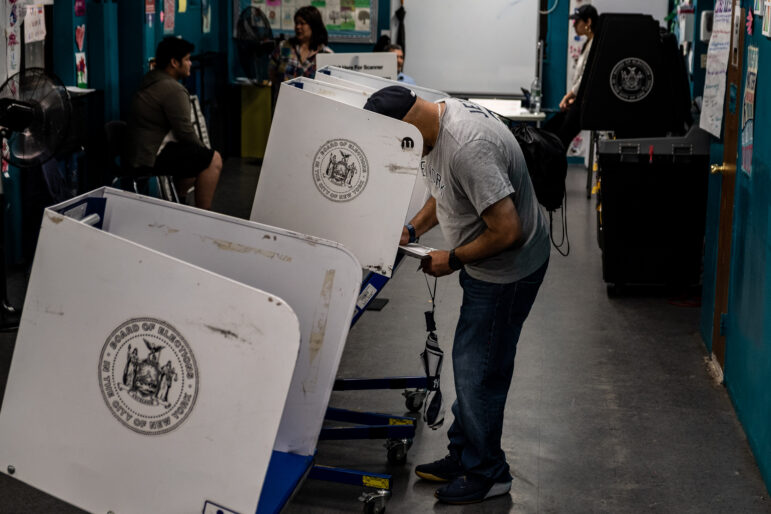
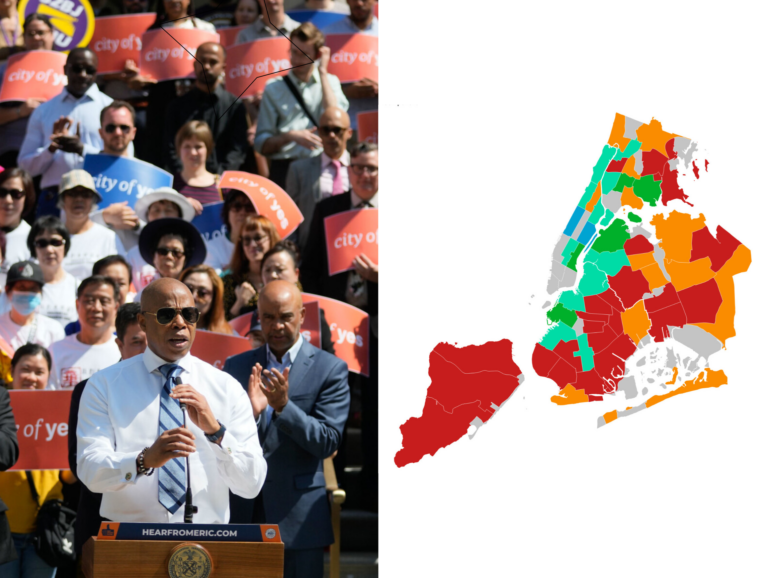
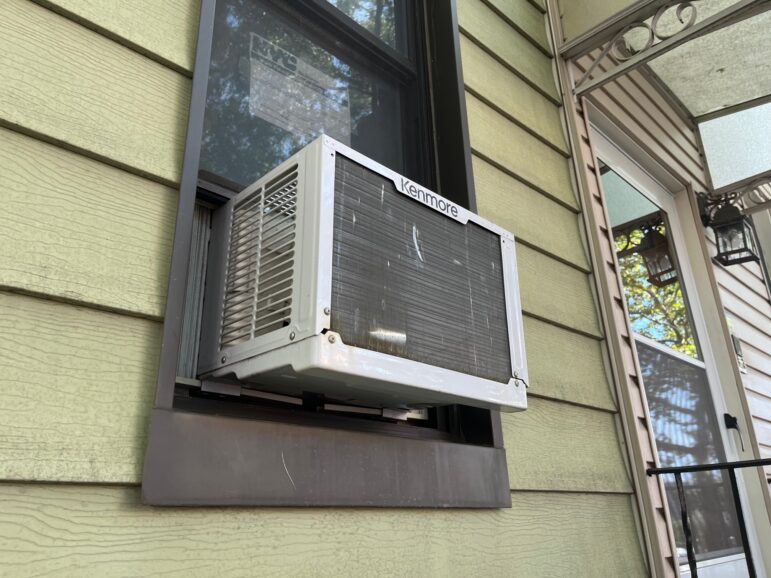




One thought on “The Secret Price of a Life”
Unions are vital. This story is about lazy workers. And if this man is found, who died, which I imagine is remaining hidden because of his lack of documents, his family etc. Could suffer. But. Where do these fees and fines go? Why can’t they go to the workers family? Shame on these developers for spinning a historic building into a coffin.